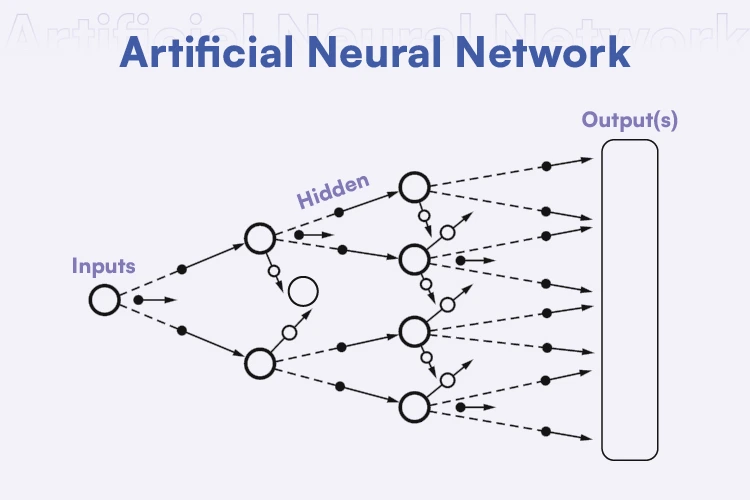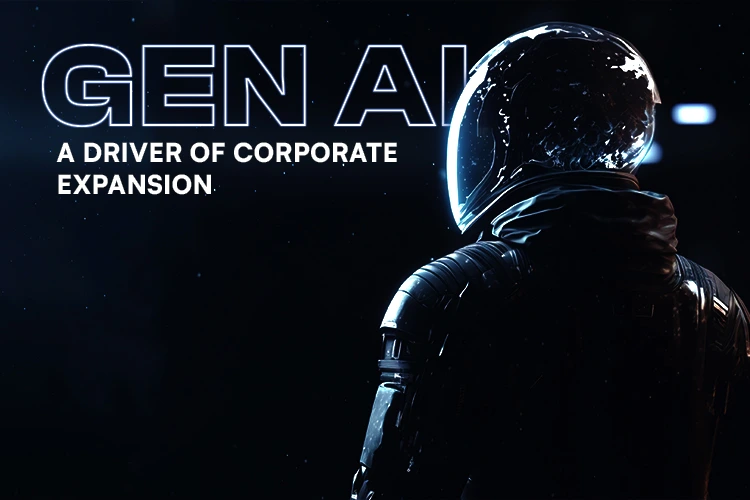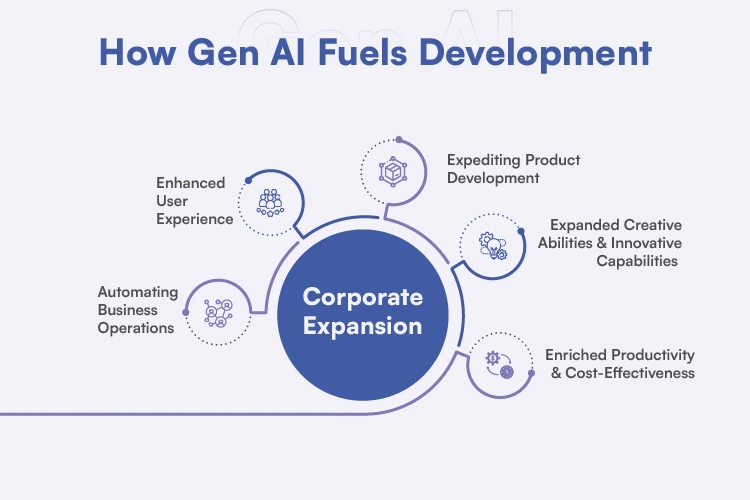“Some people call this artificial intelligence, but the reality is this technology will enhance us. So instead of artificial intelligence, I think we’ll augment our intelligence.”
—Ginni Rometty
“An AI-powered personal assistant that predicts your daily mood based on your voice intonation and recommends activities to uplift your spirits.” – This is what an AI said when asked to share an idea, introducing a new idea that humans need to only implement while AI does all the ideation.
Humans are far superior at data analysis, but machines are getting better at spotting patterns for different applications. We call this type of AI “Analytical AI.” Poetry, product design, and computer programming are all examples of human creativity. In a new field of artificial intelligence known as “Generative AI,” machines are beginning to demonstrate exceptional skill at creating works of aesthetic appeal.
Generative AI has emerged as a game-changing technology because of the substantial progress made in the field in recent years. One kind of artificial intelligence, known as generative AI, strives to simulate human ingenuity by generating original works of art like photographs, music, and even videos. Generative AI has the potential to disrupt a wide range of fields by combining deep learning methods with large datasets, from the creative arts to medicine to industry.
Work developed by generative AI is quickly surpassing that done by humans in terms of speed, cost, and quality. It might enable better, faster, and cheaper products for many different consumer markets. The goal of generative AI is to increase labour productivity and economic value by lowering the marginal cost of creative and knowledge work. Knowledge work and creative work, two of generative AI’s primary targets, employ billions of people worldwide and stand to gain at least a ten percent productivity and innovation boost from the technology. The potential economic worth of this is staggering, in the trillions of dollars.
In this post, we’ll examine what, how, why, and applications of generative AI.
To Begin, Let’s Define “Gen-AI”
“Generative models represent the next phase of artificial intelligence, where machines move beyond simple pattern recognition to create new and unique content.”
– Alex Krizhevsky, Research Scientist at Google
In a world where generative-assisted technologies exist, composing a blog post, a presentation, or a research paper might take minutes instead of days or months. These resources aid not only in the completion of our projects but also in the formation of sound judgments.
The term “generative AI” refers to data-driven software that can be taught to create original content. Services like Adobe Firefly, which can convert text into an image, and ChatGPT are both powered by generative AI.
AI with the ability to generate fresh outputs by exploiting the structures and patterns it discovers in existing data is called “generative technology.” It can make visual representations of text or audio recordings of images, or even combine the two. Chat GPT, Bard, DALL-E, Midjourney, and DeepMind are just a few of the well-known generative AI tools and models.
The system is based on a number of breakthroughs, including generative adversarial networks and large language models (LLM) with potentially trillions of parameters. To analyze data and uncover previously unseen patterns, these models utilize neural networks. The ability to make truly original works is bolstered by this. Generative AI is awesome because it can learn in various ways, such as independently or with human guidance. It’s also adaptable!
The creative and problem-solving potentials of generative AI are vast. By harnessing its potential to create something new, fascinating prospects for creative problem-solving and collaboration with machines are made possible. As it improves, generative AI forces us to think outside the box of what we thought was possible with AI and originality.
Generative AI can successfully imitate human intelligence, but it isn’t out to conquer the world. It’s a piece of equipment that needs to be instructed by a human being, typically through the use of a textual cue.

AI and Generative AI: The Difference
AI is a catchall word for any machine that can mimic human intelligence. In this context, “technology” might refer to anything from basic algorithms to complex systems that can simulate the human mind.
However, generative artificial intelligence (Gen-AI) is an area of AI research dedicated to the creation of novel content like written text, visuals, and audio. Machine learning algorithms are used to analyse enormous datasets and produce material that is strikingly similar to the training data. This has a wide range of potential uses, from artistic and musical expression to chatbot scripting.
Artificial intelligence (AI) is an umbrella term for a wide range of technologies, but generative AI is a subset of AI that aims to generate original material.
Applications of Generative AI
Presently, the worldwide market for generative AI is valued at more than $13 billion but the industry is projected to be worth over $22 billion by 2025. – Precedence research
Gen-AI is a reality because it can provide answers to pressing issues and open doors to countless new possibilities in a wide variety of industries. The applications and potential users are limitless.
Generative AI is a potent instrument for streamlining the workflow of designers, engineers, researchers, scientists, and others. Inputs like text, images, audio, video, and code can all be used by generative AI models to produce brand-new forms of content in the same or different media. It can, for instance, convert text into an image, a picture into music, or a movie into words.
The following are just a few of the main reasons why Gen-AI is a rapidly expanding area of study:
Image Generation and Enhancement:
Tools for creating and improving photographs leverage text-to-image conversion to create photorealistic results from user input. These programs can be used to make original works of art or 3D models, or they can be used to edit existing photos for purposes including image completion, semantic image-to-photo translation, image modification, and image super-resolution. Midjourney and DALL.E. are two programs that do this, helping users enhance the quality of CCTV footage.
Video Creation
Video production is made easier with the help of generative AI, which provides effective and adaptable resources for the creation of compelling content. Composing, incorporating effects, and animating are just some of the duties that can be automated. Video prediction can be performed by AI technologies, improving resolution and completion, and style transfer can be used to provide a more uniform and interesting video experience.
3D Shape Generation
3D shape synthesis is made possible by generative AI tools through the use of methods like variational autoencoders, generative adversarial networks, autoregressive models, and neural implicit fields. These aid in the creation of complex forms and improve 3D-based activities like printing, scanning, and VR.
Creating Music
While generative AIs’ ability to make new music by learning input patterns and styles is exciting, incorporating copyrighted artwork into training data remains an issue.
Text Generation
Popular text-generative AI platforms include ChatGPT, which may be used to create content like articles, blog posts, dialogues, summaries, translations, and more. Intelligent replies are generated by these systems through the use of Natural Language Processing (NLP) and Natural Language Understanding (NLU) methods. In addition, they may mimic human conversation by answering queries, categorizing text, rephrasing, and so on. Creative writing, conversational agents, translation, and advertising copy are just some of the many applications of generative AI models.
Code Generation
By eliminating the need for human coding, developers can spend less time on tasks like testing and bug fixing, thanks to the use of generative AI in the software development process. As a result, developers can quickly and simply include machine learning models like neural networks and decision trees into their program through its code completion, code generation, test case creation, automated issue repair, and model integration capabilities.
Collaboration
Personal productivity tools like email and word processing have been revolutionized by advances in generative artificial intelligence, which have greatly increased their efficiency and accuracy. Using GPT-3.5, Microsoft improves meeting recordings in Teams by segmenting them mechanically, creating titles, and emphasizing remarks. Copy for advertisements and job postings may be generated in full using Jasper. Ai’s AI-driven word processor, freeing your time and energy for more imaginative and strategic activities.
Effective Handling of Information
AI models that generate new content, such as data analytics shown in charts and graphs, have a profound impact on knowledge management because of the ease with which they process large amounts of data and information. This facilitates efficiency, reduces waste, and frees up previously inaccessible insights from massive data sets.
Gen AI: a Driver of Corporate Expansion

With its capacity for original content creation, user experience customization, and the facilitation of new strategies, generative AI has much to offer businesses. Some concrete examples of how generative AI might help a business:
-
Automating Business Operations:
Automation of operations like data analysis, customer service, and content production made possible by generative AI can be a huge boon for organizations in terms of saving time and money and freeing up human resources for more strategic endeavors.
-
Enhanced User Experience:
Using generative AI, businesses may better meet the needs of their customers through tailored product design, improved response times from support staff, and the creation of more engaging content.
-
Expediting Product Development:
Product development can benefit from generative AI by having it generate design iterations, optimize prototypes, or do performance simulations. This all has the potential to speed up the development process, cut expenses, and ultimately result in a better-quality product being developed.
-
Expanded Creative Abilities and Innovative Capabilities:

Businesses can benefit from generative AI since it allows them to generate new ideas, designs, and ideas, which encourages original thought and improves existing offerings. This innovation aids businesses in maintaining a leading position in their respective markets.
-
Enriched Productivity and Cost-Effectiveness:
Through the automation of routine operations and the improvement of processes, generative AI can considerably assist organizations by optimizing costs. This has the potential to boost efficiency and output.
Future AI and Its Effects
The way this technology is implemented can have far-reaching consequences. Gen-AI can be used to generate fresh media like songs and pictures for a number of reasons, including giving artists more leeway and inspiration. It can also be used to improve machine learning algorithms by creating new training data. Gen-AI will have a big effect since it can pave the way for the development of novel and useful content while also enhancing the efficiency of machine learning systems.
It has great potential in many fields, including medicine, business, journalism, education, and entertainment. Goldman Sachs has released a paper claiming that this technology will increase global GDP by 7% per year within the next decade. It will also cause the status quo to change. According to the same assessment, if generative AI delivers on its potential, it will have a major impact on the economy and the jobs of about 300 million people.
In its current form, most experts think, technology won’t be able to replace employees at all, only certain types of employment. However, the area appears to be developing swiftly, and consequential adjustments to the ways in which we work, study, and have fun may be on the horizon.
Challenges and Limitations:
The field of generative AI has a number of obstacles, hazards, and constraints, some of which include inaccuracy, legal ownership, and complexity in security. Since service providers can’t ensure the accuracy or stop biased content, additional checks and balances involving humans are required to steer, monitor, and validate machine-generated output. If organizations are serious about protecting data, and privacy, and preventing misuse, they must build security into every stage of the development, deployment, and use processes.
Because even slight infractions can have far-reaching effects, responsible and compliant AI systems are of paramount importance. In the end, ethical AI practices increase confidence among buyers, employees, and the general public.
Generative AI has unleashed a world of unfathomable possibilities, and we must respond to this call by wisely harnessing its power.
The Colossus of Potentiality is Emerging
In 2022, large-scale generative AI adoption was 23%. By 2025, large-scale adoption of AI is expected to reach 46%.
– Statista
Gen-AI is predicted to have long-term, far-reaching effects on the arts and entertainment sectors. While some artists and designers may be put out of business by Gen-AI tools, others may benefit from the technology by being able to find new ways to express their creativity. Artificial intelligence (AI) has the potential to improve the work of creativity in many ways. For example, it might help them produce more customized or original content or inspire them to come up with fresh ideas and thoughts.
Gen-AI has the ability to help artists improve the rate at which they produce new works. A writer, for instance, may utilize a Gen-AI system to develop the first versions of articles or stories, which they could subsequently revise and perfect. This can help creative artists save time and put their attention where it’s needed most.





